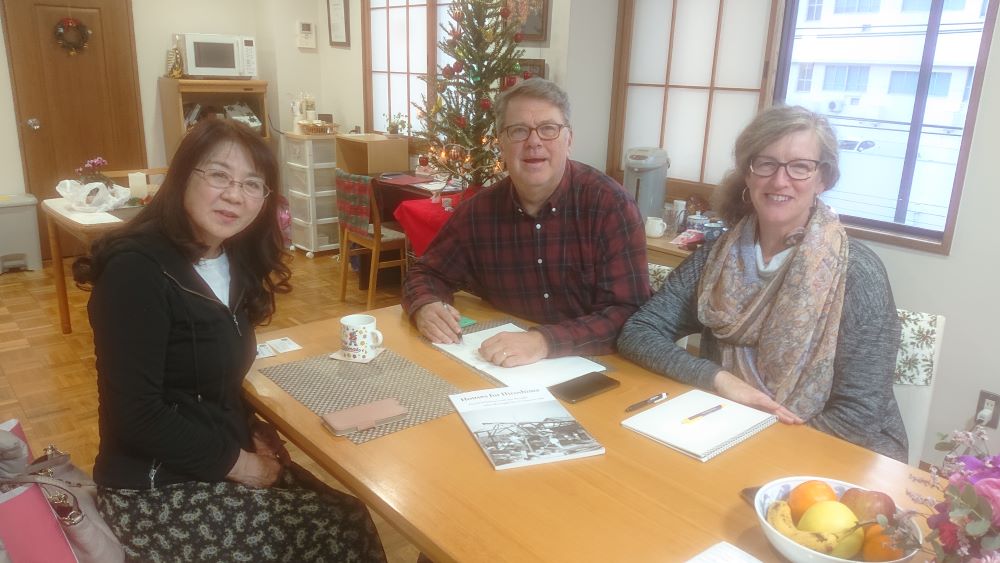WFC News
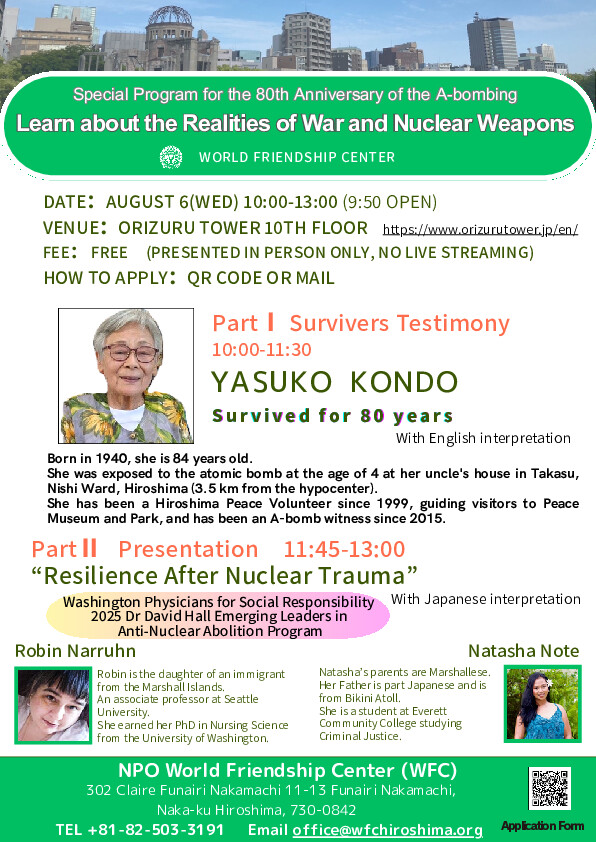
Join us for WFC’s Special Program for the 80th Anniversary of the A-bombing “Learn about the realities of War and Nuclear Weapons”
DATE:AUGUST 6(WED) 10:00-13:00 (9:50 OPEN)
VENUE:ORIZURU TOWER 10TH FLOOR https://www.orizurutower.jp/en/
FEE: FREE (PRESENTED IN PERSON ONLY, NO LIVE STREAMING)
HOW TO APPLY:QR CODE OR MAIL office@wfchiroshima.org
PartⅠ Survivers Testimony 10:00 -11:30, with English interpretation
YASUKO KONDO
Survived for 80 years Born in 1940, she is 84 years old.
She was exposed to the atomic bomb at the age of 4 at her uncle’s house in Takasu, Nishi Ward, Hiroshima (3.5 km from the hypocenter).
She has been a Hiroshima Peace Volunteer since 1999, guiding visitors to Peace Museum and Park, and has been an A-bomb witness since 2015.
PartⅡ Presentation 11:45-13:00, with Japanese interpretation
“Resilience After Nuclear Trauma” Washington Physicians for Social Responsibility
2025 Dr David Hall Emerging Leaders in Anti-Nuclear Abolition Program
Robin Narruhn
Robin is the daughter of an immigrant from the Marshall Islands.
An associate professor at Seattle University.
She earned her PhD in Nursing Science from the University of Washington.
Natasha Note
Natasha’s parents are Marshallese. Her Father is part Japanese and is
from Bikini Atoll.
She is a student at Everett Community College studying Criminal Justice.
Korean Peace Ambassadors Exchange Program (PAX) 2025, which took place from May 1 to 6, has been successfully completed. We would like to thank all the WFC community members who participated and cooperated in the program, as well as all the people we visited and those who gave testimonies and guided us around. The eight members from Korea this time were: Ms. Hye Sun Ryu (leader), Ms. Min Seo Yoo, Mr. Jang Hoon Son, Mr. Ki Chan Kim (who participated for three days from May 1 to 3), Mr. Hyun Min Bae (Restorative Justice Instructor), and Mrs. Min Ji Park, Ms. Nan Cho Jeon, and Ms. Yoon Kyung Choi. This year’s host families are Ms. Masue Matsumoto (member visiting Korea in 2019) and Keiko Capper (the member visited Korea in 2024. Daughter Minao participated in 2019), Ms. Michiko Yamane (member visited Korea in 2013), and Bradley and Susan Cox (WFC directors). And we cannot forget Coris, a traveling volunteer from Hong Kong who attended the program with us, took pictures, and posted on social media for WFC.
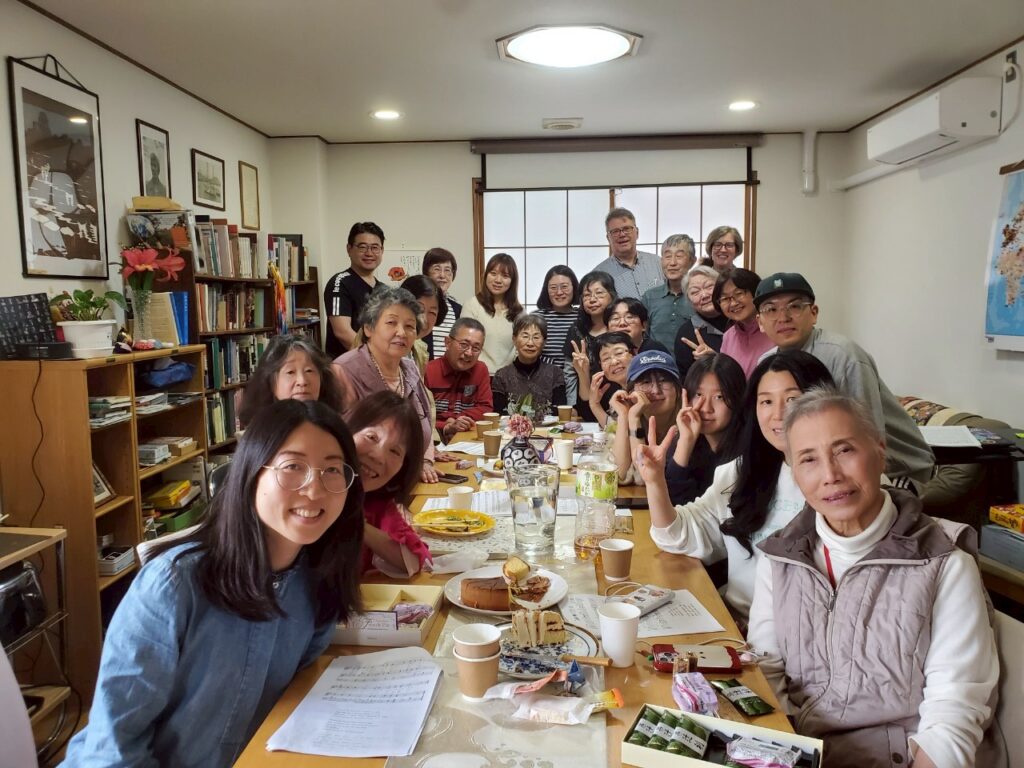
On the morning of May 1, the group arrived earlier than scheduled at Hiroshima Airport and took a limousine bus to Hiroshima City, where they were picked up and driven to WFC in the cars of the board members who met them. Lunch was a welcome potluck, prepared by members of the Peace Choir and others. Songs performed in Korean were heartwarming. Orientation with Brad talking about WFC and Barbara. We walked to Peace Park, visited the Barbara’s monument, and toured the Peace Memorial Museum. After that, they went to the homes of their host families, who took care of them for the next four days.
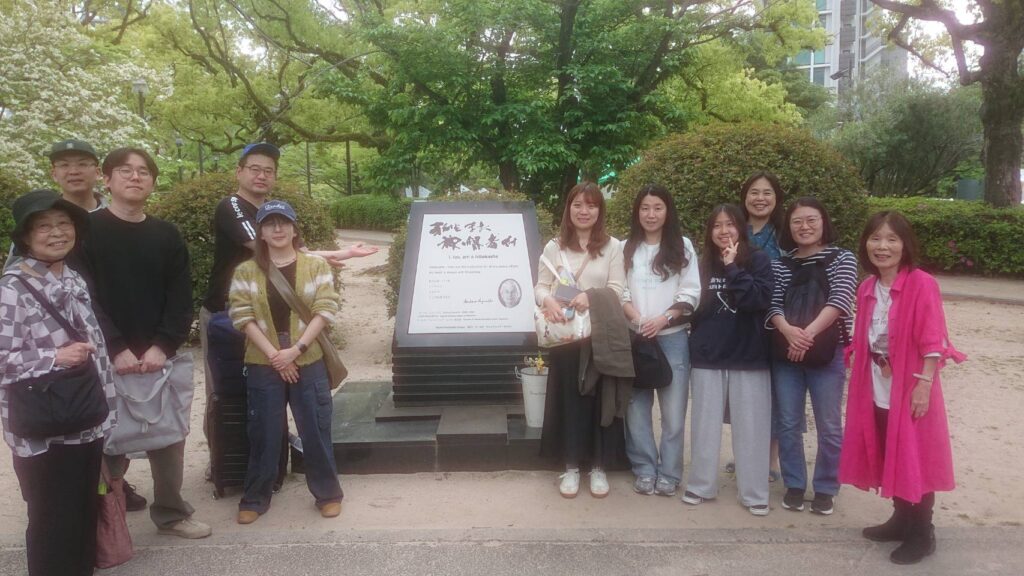
On the morning of May 2, we visited Hiroshima Korean School. Many of our members told us that this was the most impressive part of the program. We visited classes from daycare to high school, heard from the principal about the current situation of the Korean school, and then divided into three groups to have lunch with students from the junior and senior high schools. In the afternoon, we took a walk in Shukkei-en Garden, where we were assisted by Ms. Mariko Sunawaki and Ms. Yasuko Yamagata, members of the WFC community. After that, they had free time until the testimony in the evening, when they listened to a story by Mr. Jin Ho Kin, the president of the Korean Hibakusha Council of Hiroshima Prefecture at the WFC. Mr. Kin is a Hibakusha who was exposed to the bomb while in utero. He spoke directly to participants in Korean (as also done at the Korean school), and I believe that his story was conveyed to them more clearly.
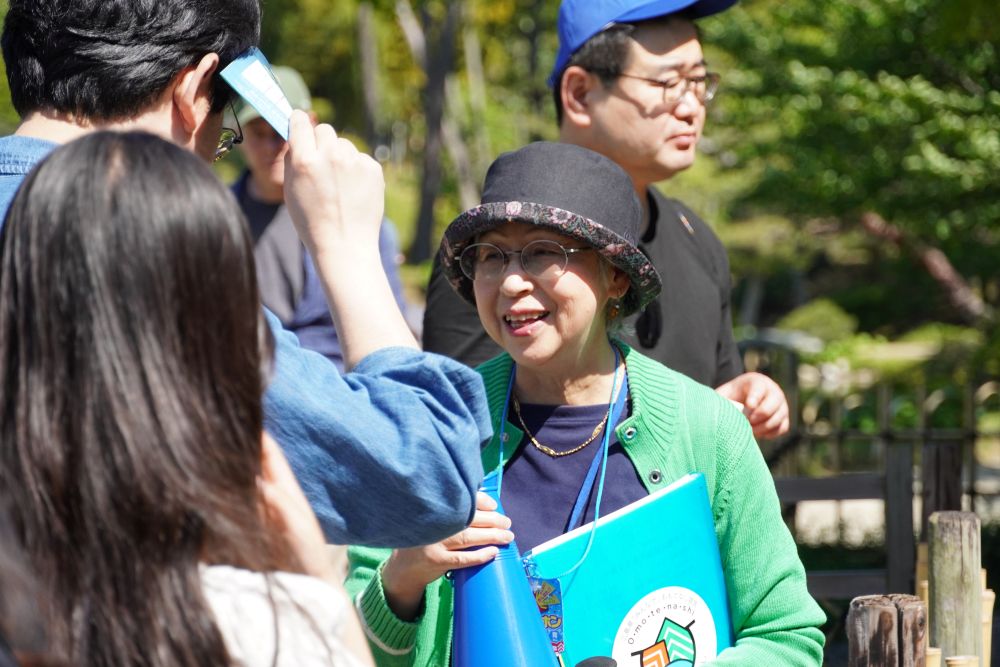
On May 3, we had a “Restorative Justice” workshop in the morning and a time of interaction in the afternoon. This is the second time we have had a public session on restorative justice, the first in 2023. With a desire to learn from each other, we planned an opportunity to learn about restorative justice, which is one of the important works of Peace Building, an exchange organization on the Korean side. After the program, we had free time. Everyone seemed to be fascinated by the newly opened Minamoa.
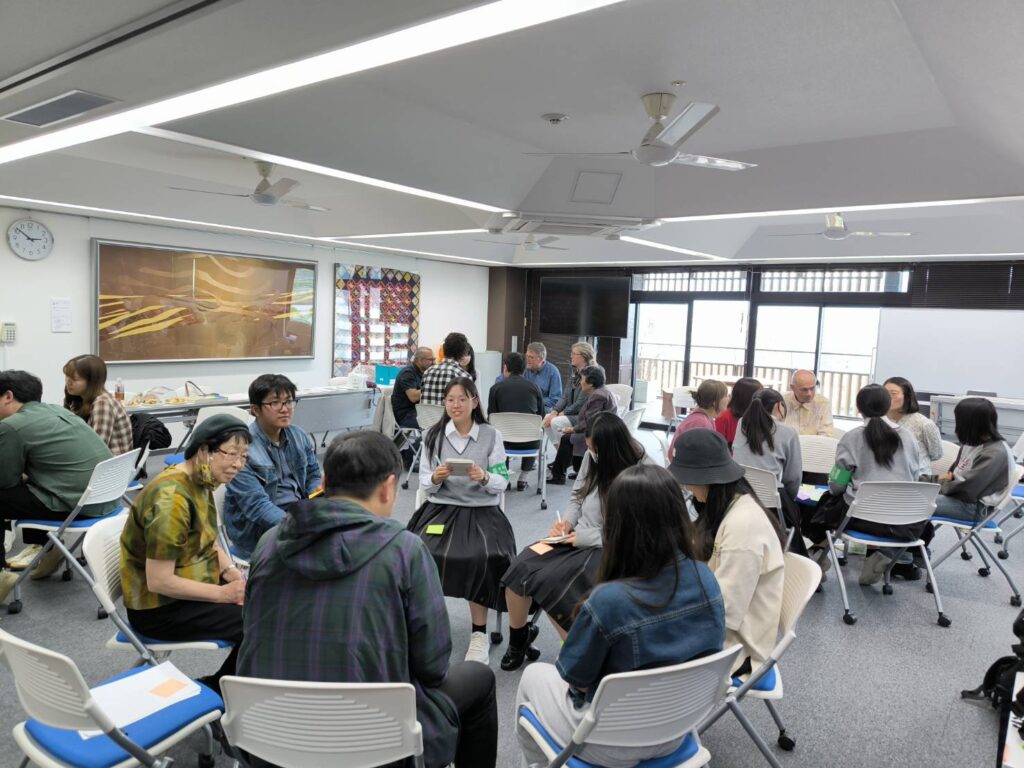
On the morning of May 4, Ayaka Fujita and Kou Motokura, two second-year students of the Hiroshima Jogakuin High School Signature Committee, led us on an English-speaking tour of the Peace Park monuments. They came to WFC in advance and worked hard to prepare for the tour, with support from Susan, the director of the WFC, who helped them with the guided study. For lunch, we had okonomiyaki near WFC. In the afternoon, we had a circle talk time to reflect on the four days and speak about what Japan and Korea mean to us through the experiences and words that printed in our hearts.
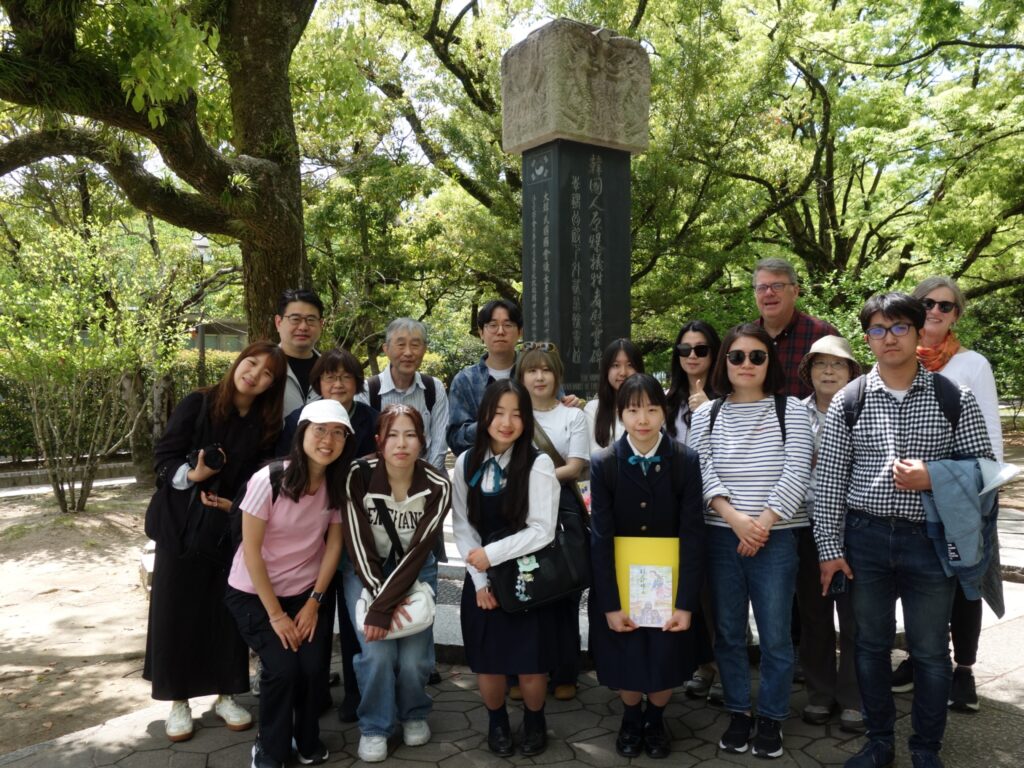
On May 5, the PAX enjoyed a sightseeing tour of Miyajima, joined by members who participated in the Korean PAX in different years, including a university student who returned home during the week, as well as members of the English class. Miyajima was so crowded with many visitors during the consecutive holidays, but they seemed to have had a good time enjoying nature (although there was an incident in which deer tried to eat their lunch boxes…). All the members stayed at the WFC that day. After the curry dinner we prepared together, we shared the message from each person and what we felt through Korean PAX. We received a commemorative plaque from the Peace Building community as a sign of our friendship over the years. Some members went to Minamoa at Hiroshima Station at the end of the day.
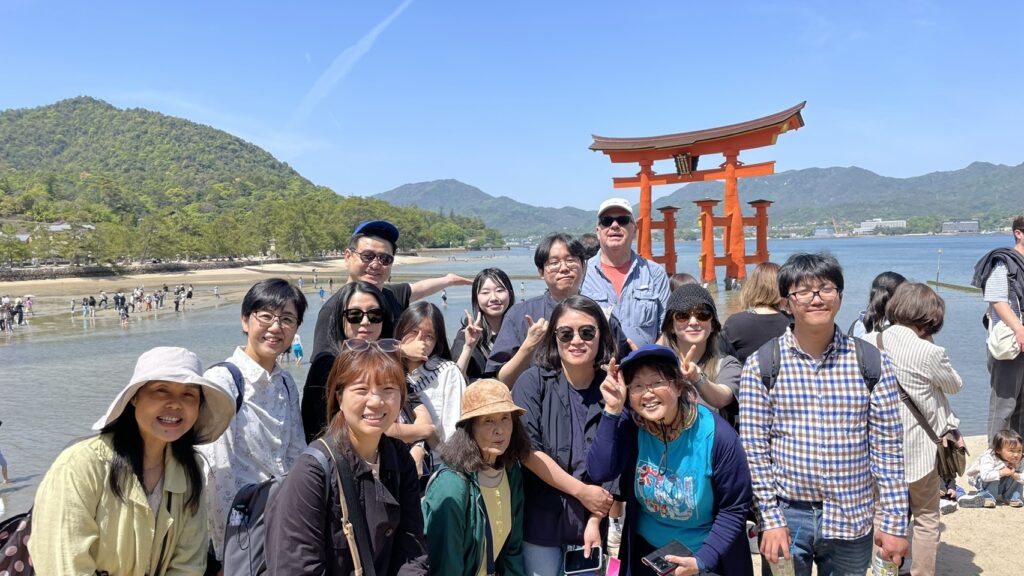
May 6. We were blessed with good weather during the Korean PAX, but it rained on the day they returned home. However, the weather was fine in the hearts. I am sure that each of us had various feelings and memories left in our hearts.
Korean PAX began in 2003. Over the 22 years since then, we have continued to visit each other, learn from each other’s past, and exchange ideas. Some of the members were surprised at how welcoming we were at the potluck lunch on the first day. Having visited Korea twice myself, I will never forget the warm hospitality I received from the Korean people. Likewise, I am sure that those from Korea will never forget the hospitality they received from their host families andthe WFC members. The photo shows a commemorative plaque given to us by the Peace Building community as a gift of gratitude. It reads, “We deeply appreciate WFC’s hard work and dedication to peace. We would like to express our gratitude for the long-standing friendship between the WFC and Peace Building and hope that solidarity for peace will be further strengthened.”
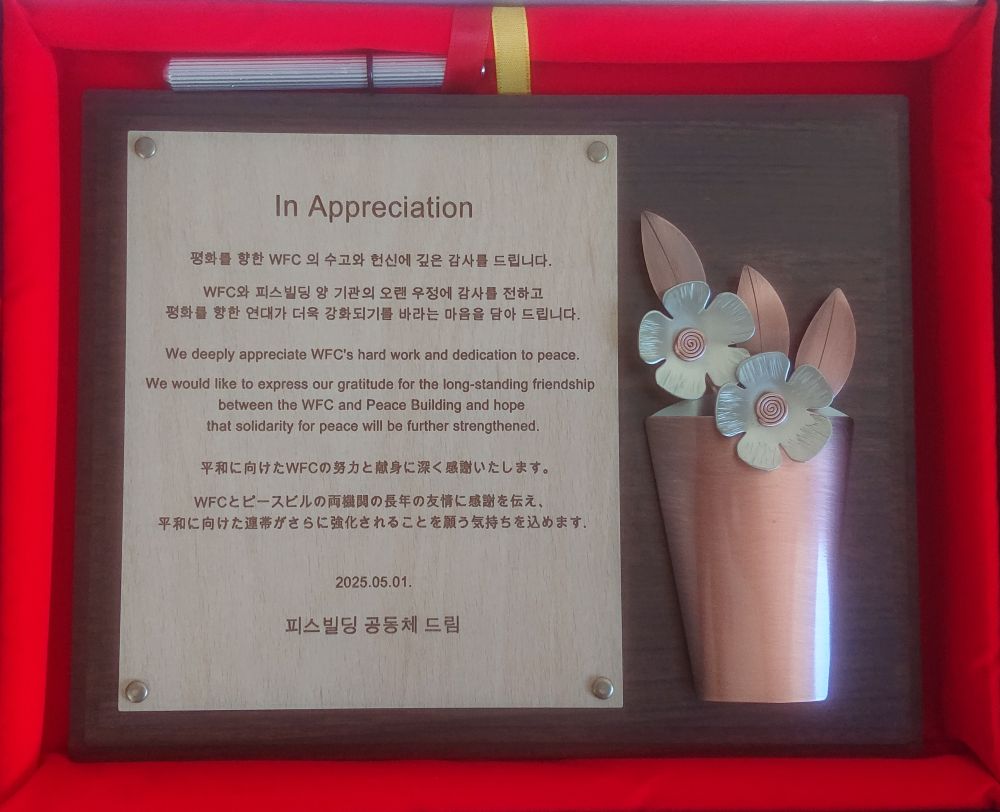
However, this was not accomplished overnight. I would like to express my gratitude to everyone who has visited Korea, everyone who has hosted members from Korea, everyone who has been involved in the planning and operation of the Korean PAX, and everyone who has supported the program.
And the relationship between WFC and the Peace Building will continue. This will require the presence of people who will be the carriers of the program and efforts to pass on what we have gained through learning from each other. This year’s Korean PAX included past participants of the Korean PAX program who have accepted host families, those who accompanied us for part of the program, and young members of last year’s program who joined us during their Golden Week break from universities. We would like to share with those around us what WFC has accomplished and cultivated through the Korean PAX programs, and would like to pass it on to the next generation.
A unique part of the program this time was a visit to a Korean school and hearing Hibakusha testimonies from zainichi, a Korean resident in Hiroshima. One of the participants mentioned this as one of the most moving parts of the PAX program. Just as the starting point for the abolition of nuclear weapons is the atomic bombing, we must never forget the starting point of our relationship with the people of Korea: why did people from the Korean Peninsula have to be exposed to the atomic bombing? Hibakusha are getting older, and it is becoming more difficult for them to participate in PAX. The same is true in Korean end. Last year, we were unable to meet with the members of the House of Sharing because they were hospitalized. Korean PAX is now entering a new stage of its history, while still valuing the importance of learning from each other.
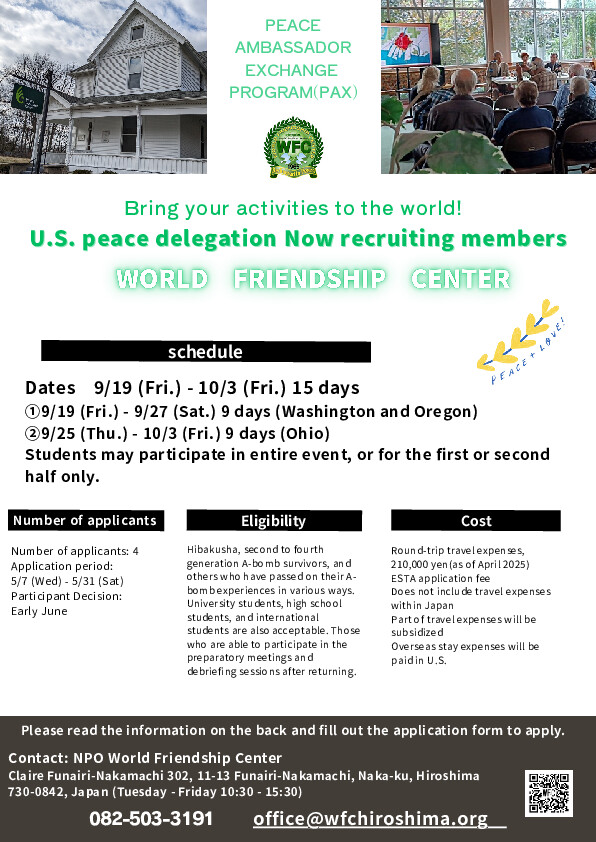
PEACE
AMBASSADOR
EXCHANGE
PROGRAM(PAX)
Bring your activities to the world!
Schedule: Dates 9/19 (Fri.) – 10/3 (Fri.) 15 days
①9/19 (Fri.) – 9/27 (Sat.) 9 days (Washington and Oregon)
②9/25 (Thu.) – 10/3 (Fri.) 9 days (Ohio)
Students may participate in entire event, or for the first or second
half only.
Number of applicants: 4
Application period:
5/7 (Wed) – 5/31 (Sat)
Participant Decision:
Early June
Eligibility: Hibakusha, second to fourth generation A-bomb survivors, and
others who have passed on their A bomb experiences in various ways.
University students, high school students, and international students are also acceptable. Those who are able to participate in the preparatory meetings and debriefing sessions after returning.
Cost: Round-trip travel expenses, 210,000 yen (as of April 2025)
ESTA application fee Does not include travel expenses within Japan
Part of travel expenses will be subsidized
Overseas stay expenses will be paid in U.S.
Please read the information on the back and fill out the application form to apply. In addition, please send a single A4 sheet of “how you can share with the American people about peace” to the following e-mail address.
Contact: NPO World Friendship Center
Claire Funairi-Nakamachi 302, 11-13 Funairi-Nakamachi, Naka-ku, Hiroshima
730-0842, Japan (Tuesday – Friday 10:30 – 15:30) 082-503-3191 office@wfchiroshima.org
Peace Ambassador Exchange In 1964, the World Peace Pilgrimage from Hiroshima and Nagasaki, organized by Barbara Reynolds, was conducted, which led to the creation of the World Friendship Center (WFC). The World Peace Pilgrimage, which called for the abolition of nuclear weapons and world peace, was a pioneering effort. The WFC held a panel exhibition to commemorate the60th anniversary of the World Peace Pilgrimage to Hiroshima and Nagasaki and provide an opportunity for the citizens of Hiroshima to learn about the World Peace Pilgrimage. The WFC had an opportunity to let Hiroshima citizens know about the World Peace Pilgrimage and how the spirit of the World Peace Pilgrimage is alive and well in the subsequent peace mission exchanges. The awarding of the Nobel Peace Prize to the Japan Confederation of A-and H-Bomb Sufferers Organizations (Nihon Hidankyo) has triggered recognition by people around the world of the importance of hearing A-bomb testimonies and of the importance of passing on the A-bomb experience. This year marks the 80th anniversary of the atomic bombing and the 50th anniversary of WFC’s sister institution, the Peace Resource Center at Wilmington University in Ohio, and the Peace Education Conference “Hiroshima and Nagasaki 30 Years Later”. In this milestone year, the U.S. PAX 2025 – Commemorating the 60th Anniversary of the World Peace Pilgrimage to Hiroshima and Nagasaki – will be planned and implemented with the cooperation of the Wilmington University Peace Resource Center. In the first half of the period, visits to the states of Washington and Oregon have been made possible with the cooperation of the American Committee of the WFC. In the places visited, the participants will convey the reality of the atomic bombings in schools, churches, and local communities, think about peace together with the American people, and appeal for the abolition of nuclear weapons and lasting peace from the standpoint of citizens through exchanges with them.
Peace Resource Center at WFC Wilmington College Founder Barbara Reynolds established the Peace Resource Center at Wilmington College after returning to the United States. We will participate in the commemorative events that will be held on September 29. Focusing on “nuclear abolition” and “the arts,” the symposium is an experiential symposium facilitated by artists to raise awareness of the need to abolish nuclear weapons as a means of achieving justice and peace in the region, nation, and world.
Honorary Chairperson Hiromu Morishita will receive the 33rd Pestalozzi – Education Award from the Faculty of Education at Hiroshima University. The award ceremony will be held on January 30.
“The Pestalozzi – Education Award was established in 1992 to recognize individuals or organizations that are carrying out outstanding educational practices in the face of extremely difficult educational conditions in our country. The award is intended to provide an opportunity to reconsider contemporary education by recognizing individuals or groups whose educational practices are in the spirit of Pestalozzi.
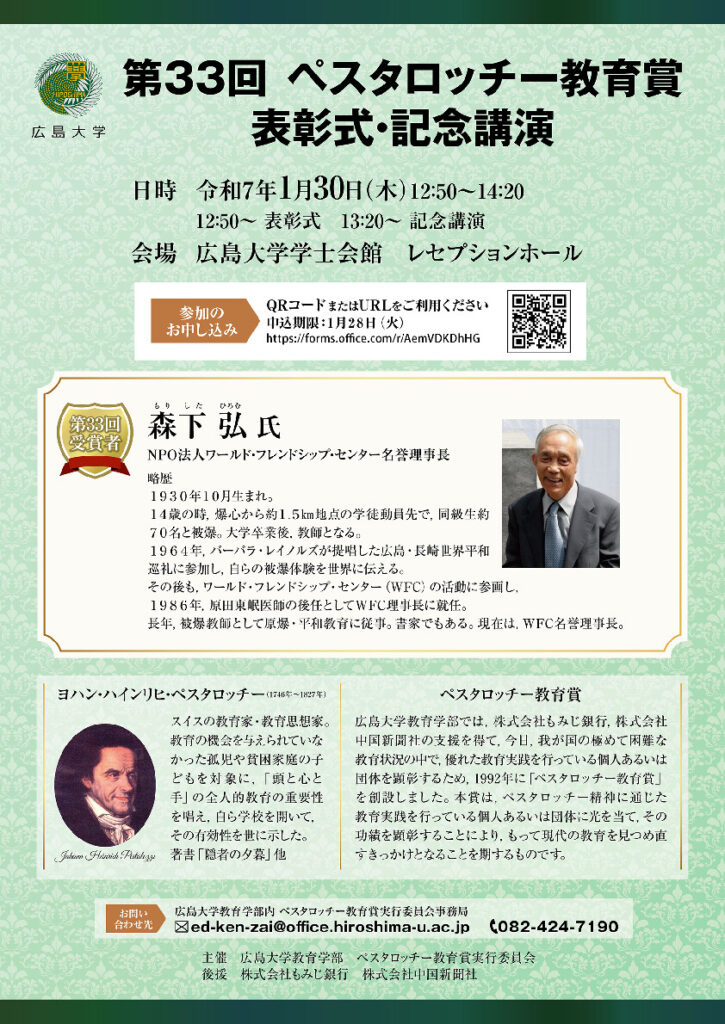
On December 11, Ms. Hiroko Nishimura of the Group for Learning from Floyd Schmoe visited WFC. Ms. Nishimura has lectured several times at WFC’s “Pass-on Project Lectures” and has helped us learn more about Floyd Schmoe.
Shortly after their assignment, directors Bradley and Susan also visited the Schmoe House in Eba with their guests. Bradley and Susan had never heard of Mr. Schmoe before coming to Hiroshima, but they were very interested in learning more about him.
Barbara, the founder of the WFC, and Mr. Schmoe, who arrived in postwar Hiroshima to construct houses for hibakusha with his colleagues, share several similarities. Both are special honorary citizens of Hiroshima City, have ties to Eba, are Quakers, and have collaborated with individuals from diverse backgrounds while living close to the hibakusha. The WFC also gives tours of the Schmoe House to guests from overseas. We will continue to work with the Schmoe Study Group to tell the stories of those who worked for peace.
